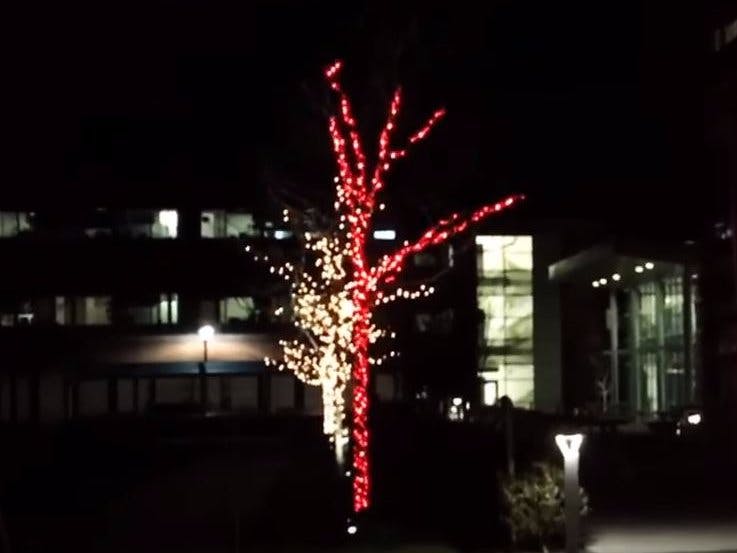// This #include statement was automatically added by the Particle IDE.
#include "neopixel/neopixel.h"
// This #include statement was automatically added by the Particle IDE.
#include "ThingSpeak/ThingSpeak.h"
/*
CheerLights
Reads the latest CheerLights color on ThingSpeak, and sets a common anode RGB LED on digital pins 5, 6, and 9.
On Spark core, the built in RGB LED is used
Visit http://www.cheerlights.com for more info.
ThingSpeak ( https://www.thingspeak.com ) is a free IoT service for prototyping
systems that collect, analyze, and react to their environments.
Copyright 2015, The MathWorks, Inc.
Documentation for the ThingSpeak Communication Library for Arduino is in the extras/documentation folder where the library was installed.
See the accompaning licence file for licensing information.
*/
#define Pixels 300
TCPClient client;
STARTUP(WiFi.selectAntenna(ANT_AUTO)); // selects the u.FL antenna
/*
This is the ThingSpeak channel number for CheerLights
https://thingspeak.com/channels/1417. Field 1 contains a string with
the latest CheerLights color.
*/
unsigned long cheerLightsChannelNumber = 1417;
//Adafruit_NeoPixel strip = Adafruit_NeoPixel(#LEDs, pin);
Adafruit_NeoPixel strip = Adafruit_NeoPixel(Pixels, 2);
unsigned long previousMillis = 0;
unsigned long previousTwinkleMillis = 0;
unsigned long previousColorUpdateMillis = 0;
const long Twinkleinterval = 10;
const long interval = 2000;
const long colorUpdateInterval = 25;
int colorRed = 0;
int colorBlue = 0;
int colorGreen = 0;
float intensity[Pixels];
float fadeRate[Pixels];
String currentColor;
int ledColors [Pixels][3];
int currentLED = 0;
bool doColorUpdate = true;
bool colorUpdating = false;
Thread* updateThread;
void setup() {
ThingSpeak.begin(client);
strip.begin();
strip.show();
// Adjust brightness 1-255 to suit your environment
strip.setBrightness(255);
for(uint16_t n=0; n<strip.numPixels(); n++) {
intensity[n] = 0.0;
fadeRate[n] = 0.0;
ledColors[n][0] = 0;
ledColors[n][1] = 0;
ledColors[n][2] = 0;
}
updateThread = new Thread("update", update);
String color = ThingSpeak.readStringField(cheerLightsChannelNumber, 1);
setColor(color);
doColorUpdate = true;
colorUpdating = true;
currentColor = color;
}
void loop() {
unsigned long currentMillis = millis();
if (currentMillis - previousMillis >= interval) {
previousMillis = currentMillis;
// Read the latest value from field 1 of channel 1417
String color = ThingSpeak.readStringField(cheerLightsChannelNumber, 1);
if (color != currentColor && !colorUpdating) {
setColor(color);
doColorUpdate = true;
colorUpdating = true;
currentColor = color;
}
}
}
os_thread_return_t update() {
while(true) {
unsigned long currentMillis = millis();
if (currentMillis - previousTwinkleMillis >= Twinkleinterval) {
previousTwinkleMillis = currentMillis;
// String testColor = "blue";
// setColor(testColor);
twinkleLEDs();
}
if (currentMillis - previousColorUpdateMillis >= colorUpdateInterval && doColorUpdate) {
if(currentLED < strip.numPixels()) {
previousColorUpdateMillis = currentMillis;
ledColors[currentLED][0] = colorRed;
ledColors[currentLED][1] = colorGreen;
ledColors[currentLED][2] = colorBlue;
currentLED++;
colorUpdating = true;
} else {
currentLED = 0;
doColorUpdate = false;
colorUpdating = false;
}
}
}
}
// List of CheerLights color names
String colorName[] = {"none","red","pink","green","blue","cyan","white","warmwhite","oldlace","purple","magenta","yellow","orange"};
// Map of RGB values for each of the Cheerlight color names
int colorRGB[][3] = { 0, 0, 0, // "none"
150, 0, 0, // "red"
255,150,150, // "pink" //100,8,58, 255,20,147,
0,150, 0, // "green"
0, 64, 128, // "blue"
0,150,125,// 0, 255,255, // "cyan",
150,150,75,//255, 255,255, // "white",
150,150,50,//255,222,173,// 255, 245, 230, // "warmwhite",
150,150,50,//255, 245, 230, // "oldlace",
150,0,150,// 255,20,147,//128, 0, 25, // "purple",
255,20,147,// 100,0,100,//255, 0, 255, // "magenta",
150,100,0,//255, 255, 0, // "yellow",
150, 45, 0};//255, 140, 0}; // "orange"};
void setColor(String color)
{
// Look through the list of colors to find the one that was requested
for(int iColor = 0; iColor <= 12; iColor++)
{
if(color == colorName[iColor])
{
// When it matches, look up the RGB values for that color in the table,
// and write the red, green, and blue values.
colorRed = colorRGB[iColor][0];
colorGreen = colorRGB[iColor][1];
colorBlue = colorRGB[iColor][2];
// colorWipe(strip.Color(colorRGB[iColor][0], colorRGB[iColor][1], colorRGB[iColor][2]),1);
return;
}
}
}
/*
void colorWipe(uint32_t c, uint8_t wait) {
for(uint16_t i=0; i<strip.numPixels(); i++) {
strip.setPixelColor(i, c);
strip.show();
delay(wait);
}
}
*/
void twinkleLEDs() {
for(uint16_t n=0; n<strip.numPixels(); n++) {
intensity[n] = intensity[n]*fadeRate[n];
if(intensity[n]<0.01){
intensity[n] = random(50,1000)/1000.0;
fadeRate[n] = random(800,990)/1000.0;
}
int r = ledColors[n][0];
int g = ledColors[n][1];
int b = ledColors[n][2];
strip.setPixelColor(n,r*intensity[n],g*intensity[n],b*intensity[n]);
}
strip.show();
}









Comments